Category Archives for "Reading"
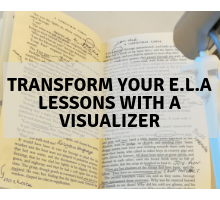
I have had a visualizer (document camera) in my classroom for a few years. I would use it once in a blue moon. Mostly to show the class something that I couldn’t copy. This year, I was thinking about how I could achieve 2 of my personal classroom targets. It turns out that my visualizer was the key to meeting both targets.
Quite a few of my classes contain groups of middle achievers, who have a tendency to sit in lessons not doing too much. They complete enough work to scrape by. They don’t cause trouble. They don’t answer questions. They are coasting. This year – I was going to change that. No more passive students!
I want to intentionally cut down on using paper in my classroom. As an English teacher, it feels like I do nothing but generate paper. Unfortunately, we have zero technology available, so that wasn’t an answer. I needed to find an alternate solution to the countless worksheets, printed articles, and practice tests I use.
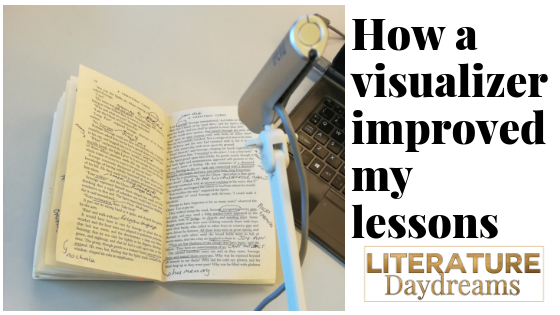
This IPEVO* visualizer/document camera proved to be the unexpected key to my success. My very no-techy explanation of what a visualizer is: it’s a camera, that plugs into your computer USB port and you can manipulate to point at a book, sheet, or whatever on your desk. It then projects the image onto your computer screen and thus onto your classroom screen / interactive whiteboard.
Perhaps you have a visualizer knocking around your department, here are a few ways you can put it to good use. If you don’t own one – I can’t exaggerate enough how much I love mine.
UK link* https://amzn.to/2OorlJh
I ‘live annotate’ my literature texts with my class. All my classes have to do examination-style tests on their literature texts. It could be a 19th-century novel, Shakespeare, poetry – they are all tested by a cold extract exam. They don’t get their copy of the book with them. No notes. Just what is in their brain.
So they need a lot in their brains!
First up is ‘live annotation’. I essentially teach the skill of reading and annotating using my visualizer. I put my blank copy of the text under the camera and as we read, we annotate together. It might be comprehension details, word meaning, connotations, themes, or links to historical context.
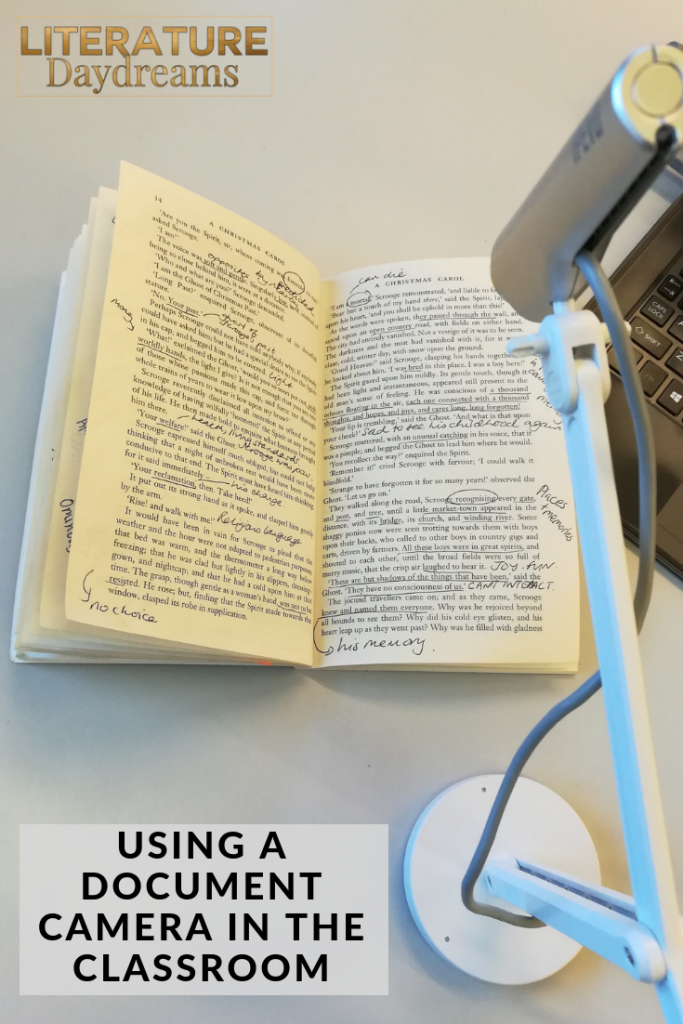
The unexpected upside for my coasting students was that this activity was so concrete and so easy at the beginning, that they got all the annotations down without even thinking about it. After all, at the beginning, all they were doing was copying.
As time passed, I asked more questions “what should we be annotating here?” and it felt much less like spoon-feeding my students. Everyone was so comfortable by then that they would be suggesting ideas. They had learned a skill which wouldn’t necessarily have come naturally to them!
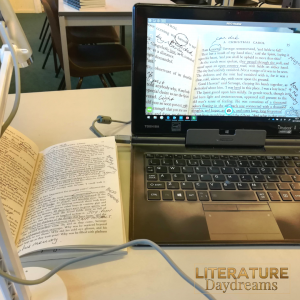
I can’t tell you how many times I have printed and copied 30 blank table worksheet for my class to fill out. Just because I couldn’t be bothered to go through the hassle of explaining exactly how many columns and rows were needed. I admit it, I was lazy. I couldn’t deal with “I’ve run out of room!” or “It doesn’t fit in my column!”
Now I just use my visualizer to demonstrate exactly what I want the table to look like. I get a blank piece of paper, line it up under my visualizer, draw the first line – everyone copies – draw the next line. It probably takes about the same amount of time as handing out 30 sheets and getting them glued in books.
The secondary upside is my meager contribution to saving the planet by reducing copying!
In addition to my coasting students, I have a few classes that really struggle with English. Although these classes tend to be smaller and specialist, it is always hard for me to get around and spend time with every student.
I use my visualizer as a way to provide me with more 1-2-1 time with certain pupils. Let me give you an example: say we are covering the difference between showing and telling. We complete the first task together, on the visualizer (which means I can also model good handwriting etc). I leave the work on the screen, so my slower writers can take their time to write it down.

I can then circulate around the class to give individual support.
This works better than going through the work verbally because I don’t have to keep repeating myself.
It also works better than typing the work onto my screen / whiteboard because I can interact directly with the ideas – I can circle words, change them, highlight, put stars by things as I am explaining.
I’ve saved the best to last. This idea has made a huge difference to my students progress. I started ‘live marking’ in the same way that I did ‘live annotating’. My classes would complete a piece of creative writing or an essay. I would take responses from 4 – 5 volunteers and mark them live using the visualizer.
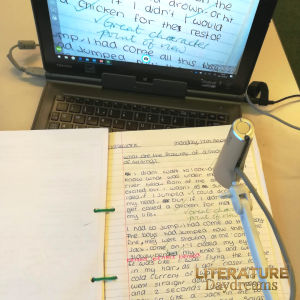
Let me break it down for you: say you wanted to work on thesis statements. I would ‘live mark’ those 4 – 5 pieces of work by placing them under the visualizer and looking at just the thesis statements. We would work out together which were the strongest, how to identify the weaknesses, and how to improve any that needed improvement. The rest of the class would then look at their own thesis statements and self-assess.
These are just a few ways that I use a visualizer in my classroom!
Leave a message in the comments if you use a visualizer. I’d love to find even more ways to use it in my classroom!
*These links are affiliate links, you don’t pay any more or any less by using this link. It does mean I get a small commission – which helps keep me in cups of tea!
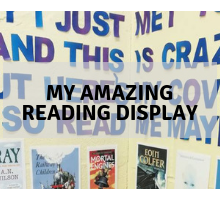
This gorgeous reading display is perhaps one of the best things I’ve added to my classroom in ages. And not just because I get to play Carly Ray Jepson songs in class… I cannot claim the idea is mine. But I do adore how it turned out! Here’s how I went about it and how you can swipe the download!
This week I updated the display in one pokey corner of my classroom. It’s one of those things that I had been meaning to do for a-g-e-s. But because the space was generally well hidden by the 5 tonnes of stuff I accumulated last year, it hadn’t been a high priority. Karma happens, though right? We had visitors in school and my classroom needed to be pristine. Or prestige, as my students would say!
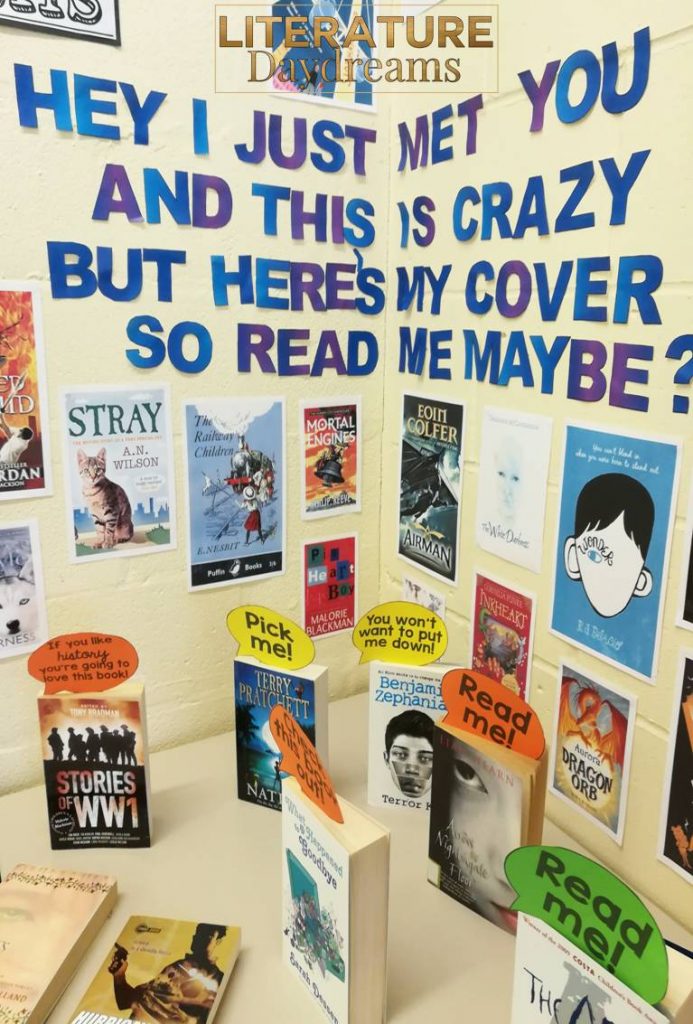
This cute rhyme is a play on Carly Ray Jepson’s song “Call Me Maybe”. All my students ‘got it‘ as soon as they saw the wall. They groaned and shook their heads, enjoying a moment of teenage indignation. I then asked them for their best book suggestions. So it’s their book recommendations, plus a few from my colleagues, that I placed around the rhyme! Read on to see how I made it and to swipe my files!
Before I get into the practical details – I wanted to give a shout out to the amazing Jessica Lawler from Joy in the Journey. Check out the ‘Read me!’ and ‘Pick me!’ labels in my books! Don’t you just l-u-r-v-e them!! They are also a sweet treat of free download, Jessica has them on her TpT store and you can download them for free >>here<<.
Ok, ok. I know what you want. Here is how you can get stuck into this in your classroom. It really is as simple as 1 – 2 – 3.
So all you need to do now is get the SWIPE file!

Love reading in your classroom with this fun reading display! Download your freebie now and click to receive regular ELA teaching tips, tricks, and ideas!
*I send emails with teaching tips, tricks, and free resources to my subscribers regularly. I value your privacy and you can learn more about how I handle your data in our private policy. You can unsubscribe at any time.
This thing happened and it was good.
There are times when something spontaneous happens in the classroom and the results are so unexpectedly cool that it is hard not to stop and enjoy.
We have had a big push on reading with our reluctant KS3 readers over the last couple of weeks. You know the kids I mean. These aren’t the bright, top set kids – who are reading Thomas Paine’s The Rights of Man at the age of 12 – these kids are the ones who declare proudly “I’ve never read a book” or “I’ve only read one book ever – it was George’s Marvellous Medicine in year 3”. My personal favourite: “I hate reading.”
This is my class in year 8. Unsurprisingly they are mostly boys, mostly the cheeky ones you see cutting in the lunch queue, mostly the ones who haven’t made much progress.
It became obvious, when I picked this group up, that our KS3 curriculum wasn’t going to cut it. We needed to read, read, then read some more and then read and keep reading. At first most were struggling to read a sentence fluently. Some were unable to read words with three or more syllables. Remembering what we read from one week to the next was an issue. Trying, and learning to keep on trying, even when it got tricky and embarrassing, was as important as learning how to do the reading thing.
So far this year we have read two novels. I won’t bore you with which ones; nothing fancy, books had been sitting in our book cupboard for a few years. Chosen to meet the criteria of being just hard enough to aid learning and with a storyline that was relatively easy to hook onto and remember. After that we read a translation of Grendel and now we are reading non-fiction texts.
I won’t sugar coat it. Reading extended texts with this class is still tricky. Decoding, comprehension and inference skills are improving, but reading has never felt fun in these hours. Reading is still hard. Very hard.
Fast forward then to last week and World Book Day. We start every lesson with 10 minutes of silent reading – most are doing the Diary of Wimpy Kid thing, some have borrowed from my extensive collection of Horrible History books. They are reading though. Not just holding the books and daydreaming. Eyeballs move. Hands go up – “what’s this word Miss?”. Spontaneous comments “This book is funny Miss”. They are reading.
The non-fiction text of the week explained how chicken nuggets are made. Yep, it caused a stir. We tackled the vocabulary – consumption, tempura, raised (as in chicks raised in factories for consumption) etc. Yum!
I then posed the challenge. “I have never eaten a chicken nugget. Can you create a clear argument that would convince and persuade me to eat a nugget?” After the horrific realisation that they were in the same room as a vegetarian, we looked at writing an argument.
The kids wrote. We peer marked. I have worked hard with this class to develop their basic literacy skills through peer marking. We have a set of criteria and use it every lesson, it has numeric scores (i.e. if they have started every sentence with a capital letter, award them 5 marks) and the boys seem to like the clarity this presents. We champion improving on previous scores. They usually get house points if they are in the top 10%.
Here’s the thing that happened. It was World Book Day. I had been showing off some books that we had been sent and whooping generally about reading. Cheeky Billy piped up “Miss, I want that book. If I get top marks today, can I have it?”
My response was “Heck yes!” After all, what else was I going to do with these books?
Eight other voices called out – “Can I have one if I get good marks?” Affirmative from me.
And so the writing was on. The focus in the room was a notch higher than usual. Muttering could be heard “I need to use an exclamation mark”.
Writing done, peer marking completed, attempts to exploit the marking criteria were batted away and four books were handed out.
The whole class crowded around the box, giving their opinions on each option, helping the lucky four make their choices. Cheeky Billy lost out. His frustration was good humoured “I’ll give you my World Book Day voucher.” Then inspiration struck “Can I earn one tomorrow Miss?”
I grinned and nodded, booting them out the door to lunch and forgot about it.
The next morning, I was on gate duty, four of my gang of boys arrived after the bell shouting “I’m gonna earn that book today Miss.” And so last lesson on Friday afternoon arrived and the remaining gaggle of 11 kids proved themselves desperate to earn a book.
At the end of the lesson, there was pushing and shoving over the last two copies of Cuckoo Song by Francise Hardinge.
Let me repeat, these boys – self-declared haters of reading at the beginning of the year – were pushing and shoving over a book. A book. I could have wept with joy. My job is the best job in the world
Today a whole week later, they are still talking about it. Still telling me what is going on the books they are reading. Still telling their mates that I gave them a book. Still telling their parents that they earned a book at school.
This thing happened and it was good.